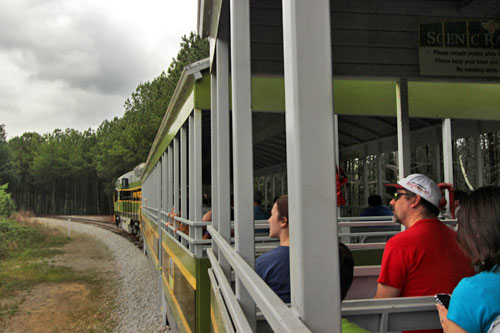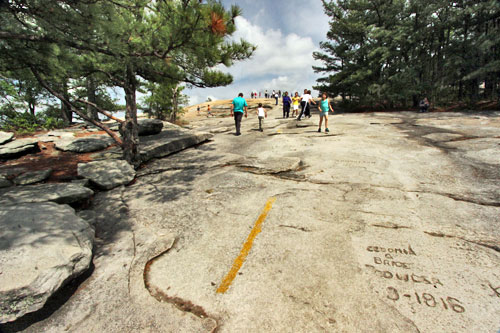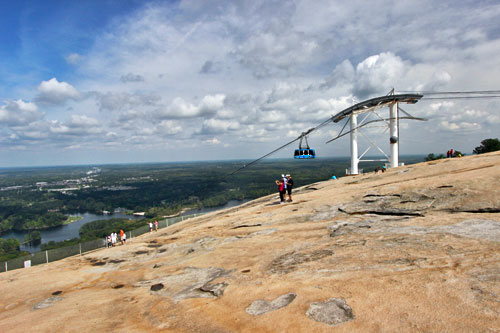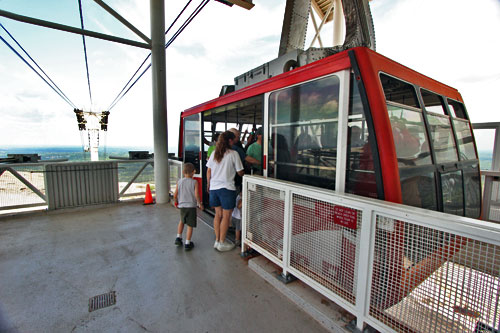My first glimpse of the monumental sculpture carved into the massive granite dome known as Stone Mountain was slightly disappointing. From the viewing platform the three sculpted figures of Confederate President Jefferson Davis, General Robert E. Lee and Lt. General Thomas “Stonewall” Jackson were dwarfed by the sheer immensity of the naked rock that thrusts 1,683 feet above sea level from an otherwise flat plain. I had expected the carving, often compared to South Dakota’s Mount Rushmore, to be bigger, more impressive. Then I stepped inside the museum at Stone Mountain Park and quickly discovered that first impressions can indeed be deceiving. The image of the three men towers 400 feet above the ground and is larger than a football field. Measuring 90 by 190 feet, the carving is a full thirty feet higher than Mount Rushmore and a six foot man can stand inside the mouth of General Lee’s horse! Even more surprising, for nearly half a century the attempt to create this memorial to the Confederacy was little more than a pipe dream.

The project was first envisioned by Caroline Helen Jemison Plane, a charter member of the United Daughters of the Confederacy, who in 1915 approached sculptor Gutzon Borglum to sculpt a 20-foot high bust of General Lee on the face of the mountain. Borglum, who would later become famous as the sculptor of Mount Rushmore, accepted the commission and immediately lobbied to expand the project, insisting that “…a twenty foot head of Lee on that mountainside would look like a postage stamp on a barn door.” Given my initial reaction, there is little doubt that Borglum was correct but his grandiose counter-proposal was for a project the size of which had never before been attempted: he envisioned a sculpture of seven central figures followed by “an army of thousands.” World War One delayed the onset of carving, but finally in 1923 Borglund was given $250,000 and allowed to start. Less than seven months later he unveiled the completed head of Lee on the General’s birthday, but the sculptor’s dictatorial attitudes were winning him no favor and by 1925 his contract had been cancelled over irreconcilable differences.
Enter sculptor number two, Augustus Lukeman, whose first action was to dynamite any evidence of Borglum’s work off the face of the mountain and begin anew. Three years later funds ran out during the Great Depression and once again the project was shelved – this time for 30 years, until the the State of Georgia purchased the mountain in 1958 and made it a state park. The Stone Mountain Memorial Association (SMMA) was established and tasked with the responsibility for completing the sculpture and constructing a plaza at the base of Stone Mountain. Following an extensive selection process, SMMA selected Walter Hancock to finish the project and work began again in earnest in 1964.
Hancock, a renowned sculptor in his own right, referred to himself as the consultant on the carving and not the sculptor, explaining in a 1977 interview with Robert Brown, for the Archives of American Art: “Because the carving after all had been begun from a model by Augustus Ludeman, and it was clear that the only way that it could be carried out was to continue with Ludeman’s model. So I felt that I was simply a consultant and not the sculptor…”
Though Hancock used Lukeman’s models and sketches as a basis for his design, he felt that Lukeman’s partially finished sculpture had some enormous mistakes in proportion.
“It had a kind of fine monumental quality, but the heads of the figures were large enough to be those of six-year old boys, and they couldn’t have been made to look like dignified leaders of the Confederacy… Unfortunately, it had been carried so far that there was no going back. Davis’ head had been finished by Ludeman’s carvers and it had been finished very well. It is a very handsome piece of portraiture and carving. The Lee head was almost finished, the Jackson head not at all. I had to saw up the cast of Ludeman’s model, fill in the missing pieces, lengthen the arms, lengthen the torsos, lower the bodies of the horses in order to give the men enough room, enough presence to live up to their heads. This brought the horses down to below the line which had been cut by the original carvers. There were deep channels cutting right through what we would have liked to have as the material for the large horse and their legs. So, it was clear that the legs of the horses could never be carved.” (sic)
The modifications were accomplished via “patching,” which became one of the greatest challenges of the entire project. The host of professional quarrymen who had been hired to do the day-to-day carving cut giant blocks of granite from the side of the mountain, built train tracks from the quarry site to the carving site, loaded the giant blocks and transported them by rail. The blocks were then lifted into place and secured with five-foot long steel pins and mortar, following which the “plug” was carved to match the rest of the figure. A large block used to augment Lee’s chest weighed four and a half tons, while two smaller blocks were used to beef up his elbow and forearm. Additional patches were also added to one of the horse’s heads, Jackson’s beard and collar, and to Davis’ hat.
Once the patches were solidly in place, master carver Cohen Ludwig, who had been hired by Hancock, re-worked the head of Jackson and the head of Davis’ horse. Ludwig was an on-again, off-again participant during these years. Though he very much wanted to finish the sculpture, he suffered from intense fear of heights. Finally, in 1968, he quit for the third and final time, and once again the project was left without a master carver. By this time, sculpting had shifted from the tedious process of hand-chiseling to the use of a propane-fueled jet torch that burned at 3,500 degrees Fahrenheit and easily chipped away at the granite. Roy Faulkner, a simple quarryman who had long worked on the project and had become proficient in the operation of the jet torch, took over and saw the project to its end. Ironically, more than half a century after its initial conception, the world’s largest high relief sculpture was completed by a man who had never had a day of artistic training in his life.

With renewed respect for the memorial I climbed aboard the Scenic Railroad for a five-mile circuit of the mountain, but ground-level left me wanting more so I tackled the trail to the top. An initial expanse of slick rock led into a pine forest, where the trail wound through boulders scattered among the trees like giant marbles. Soon I was past the treeline, baking under a midday sun that seared from above and reflected waves of heat from the bare rock beneath my feet. The ascent grew increasingly difficult and at one point was so steep that handrails had been installed; without them I surely would have slipped backwards or even tumbled down the mountain.

Breathless and sweating I reached the summit; I faced into the blustery winds that continually scour the mountaintop, spread my arms wide, and gratefully allowed the breeze to refresh and renew me. Standing directly above the carving, I tried to imagine hanging off the face of this mountain, day in and day out, in pelting rain and violent windstorms, while jockeying a propane torch and carving on a scale that could only be viewed from below, never knowing whether the work that had been done was correct until descending to the ground each evening.


I opted to ride the high-speed Swiss cable car down the face of Stone Mountain, which provided me with a birds-eye view of the Confederate Memorial Carving, and headed back to the main lawn for the Lasershow Spectacular, a dazzling display of neon laser lights and fireworks choreographed to popular musical scores, projected upon the face of the mountain. As the final orgasm of fireworks illuminated the sculpture in shades of vermillion and purple, I thought not of the Confederate Heroes memorialized in stone, but of the dedicated people who worked for years to bring this unique piece of art to fruition, and I bowed my head to honor their accomplishment.
Visiting Stone Mountain Park:
Stone Mountain Park is located just 16 miles northeast of downtown Atlanta, Georgia. Atlanta’s public transportation service, MARTA, drops off in the city of Stone Mountain, about ½ mile from the Park’s West Gate. Many hotels offer transportation to the Park, and it is also possible to hire a taxi.
In addition to the historic carving, Scenic Railroad, Summit Skyride cable car and Lasershow Spectacular, the park offers an array of attractions that range from the Geyser Towers, which features multiple levels of suspended rope bridges and net tunnels connected to towering platforms that overlook a gushing geyser, to rides on 1940’s era Army all-terrain vehicles known as “Ducks” that take a big splash into Stone Mountain Lake.
The park is open year-round however, during the spring and fall, some attractions may only be open on the weekends. Park gates are open daily, 6:00 a.m. to Midnight but hours of the attractions vary. The Lasershow Spectacular starts just after dark and guests are allowed to bring food and non-alcoholic drinks into the park and enjoy a picnic on the main lawn before and during the show.
Vehicle entry to Stone Mountain Park requires a valid Parking Pass which must be purchased at one of the entrance gates to the Park. The price is $20 per vehicle (car, truck or motorcycle) for up to 14 people, and the one time fee allows multiple entries that same day. Vehicle entry ticket is valid for access to public picnic areas, hiking and nature trails, children’s playground, walk-up trail, Quarry Exhibit, the Confederate Hall Historical & Environmental Education Center and the Lasershow Spectacular. Other attractions, such as the Scenic Railroad, Skyride and Duck Rides, are priced separately. Alternatively, All Attraction Passes may be purchased. Bicycles and pedestrians can enter at no charge.

We were just at Stone Mountain last month. Wow! Very impressive carving, although the history of how it came to be made us a little uncomfortable. But it’s worth seeing!
Hi Lance: It is worth seeing, and what surprised me most is that it’s even bigger than Mount Rushmore!
This is awesome! I can’t believe I missed it when I was in Georgia…going to have to make a return trip for sure.
Glad you liked the article, Christian, and hope you get to see it on your next trip to Atlanta.
I spent many teenage weekends climbing Stone Mountain. Thanks for recapturing memories from my Atlanta childhood.
Wow, even just through the 1st picture the relief-sculpture is stunning. It’s so tempting to picture ourselves lying on the colorful cover on the grass with such a view!
It good implementing rope cars for tour places in mountain places , because all age groups can go there without any trouble
When I was a kid?, my school visited Stone Mountain on a
field trip. I loved every minute of it. Seeing this video brings back a lot of
memories.
Sculptures are the most beautiful manmade crafted things in the this world.The people involved in making this sculptures spend plenty of time in making sculptures and to colour and decorate them…………..
Boston Park Plaza Hotel
Wow,
Great tour..i love travelling..thanks for sharing with us..
praveen
mytravelo.com
i hope u visit now
Out of all the times I have visited Atlanta, I have never been to Stone Mountain. I must make a visit there soon. Some very interesting history.
Being from New Jersey, I always found the Confederate stuff in Georgia a bit odd, especially the laser show at Stone Mountain. Definitely an impressive carving though!
Whatever this stone mountain is, it sure looks amazing!
I’ve never heard of this mighty monument. What a story that goes with it.
Hi Mark: I hadn’t heard of it either, until I spent some time in Atlanta. I find it remarkable that it is so little known outside of the local area, despite its fascinating history!